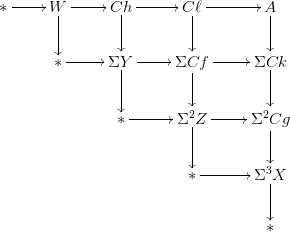There is an argument that this Toda bracket does not contain zero. However, it uses the relationship between vanishing Toda brackets and the ability to iteratively factor through mapping cones. Let's sketch that first.
Suppose we have a triple composite $X \xrightarrow{f} Y \xrightarrow{g} Z \xrightarrow{h} W$. If $gf$ is nullhomotopic and $hg$ is nullhomotopic, then there exists nullhomotopies: paths $K: [0,1] \to Map_*(X,Z)$ from $gf$ to the trivial map, and $L:[0,1] \to Map_*(Y,W)$ from $hg$ to the trivial map. Gluing together $h \circ K$ and $L \circ f$, we get a map $S^1 \to Map_*(X,W)$, or $\Sigma X \to W$: a representative for the Toda bracket. Choices of $K$ and $L$ change this element. If the Toda bracket contained zero, then we could make choices of $K$ and $L$ so that this map is trivial: it extends to a map $D^2 \to Map_*(X,W)$.
If this is true, then we can use this data to build a space. The nullhomotopy $K$ of $gf$ allows us to factor $g$ through a map $k: Cf \to Z$ from the mapping cone. The nullhomotopy $L$ allows us to factor $h$ through a map $\ell: Cg \to W$. The map from $D^2$ above allows more: it allows us to factor the map $\ell$ through a map $p: Ck \to W$ from the mapping cone. And then we can take the mapping cone on $p$: a space $A$. This space $A$ would live in a diagram of homotopy pushouts:

Let's we apply this to the composite $S^5 \to S^4 \to S^4 \to S^3$ you described. First, we get a map $k: C\eta \to S^4$ (the source has a 4-dimensional cell and a 6-dimensional cell). Then, extending over the mapping cone, we get a map $p: Ck \to S^3$ (the source has a 4-dimensional cell, a 5-dimensional cell, and a 7-dimensional cell). Finally, we take the cone on $p$, getting a CW-complex $A$ with cells in dimensions 3, 5, 6, and 8. The attaching maps for the cells are related as well: $\eta$ is the attaching map for the 5-cell to the 3-cell; $2$ is the attaching map for the 6-cell to the 5-cell; $\eta$ is the attaching map for the $8$-cell to the $6$-cell.
Moreover, on cohomology we'd find that $H^*(A)$ is $\Bbb Z/2$ in dimensions 3, 5, 6, and 8 (one for each cell), and $0$ elsewhere. The attaching maps are also detected by Steenrod operations: $Sq^2$ takes the 3-dimensional generator to the 5-dimensional generator; $Sq^1$ takes the 5-dimensional generator to the $6$-dimensional generator; and $Sq^2$ takes the $6$-dimensional generator to the $8$-dimensional one.
However,
$$
Sq^2 Sq^1 Sq^2 = Sq^2 Sq^3 = Sq^5 + Sq^4 Sq^1 = Sq^1 Sq^4 + Sq^4 Sq^1
$$
and the latter operation, applied to the generator in degree 3, must be zero because all the terms factor through the zero groups $H^4(A)$ and $H^7(A)$.
Let's say we know $\pi_6(S^3)$, the home for this Toda bracket. It is $\Bbb Z/12$: it is a subgroup of $\Bbb Z/24 \cdot \{\nu\}$, the third stable homotopy group of spheres. The bracket involves 2-torsion homotopy groups and so it has to live in the 2-torsion part $\Bbb Z/4$. The indeterminacy in the bracket is the image of the Hopf map $\eta$: this is the subgroup $\Bbb Z/2$. So this leaves us little choice: the bracket $\langle \eta, 2, \eta\rangle$ is $2\nu$, up to indeterminacy.
We note that $Sq^1$ detects $2$, $Sq^2$ detects $\eta$, and $Sq^4$ detects $\nu$. It is no accident, given this, that $\langle \eta, 2, \eta\rangle = 2 \nu$ at the same time that we have the Adem relation $Sq^2 Sq^1 Sq^2 = Sq^4 Sq^1 + Sq^1 Sq^4$. Relations between Steenrod operations detect brackets in the homotopy groups of spheres (and, conversely, relations between elements in the homotopy groups of spheres detect brackets between Steenrod operations).

